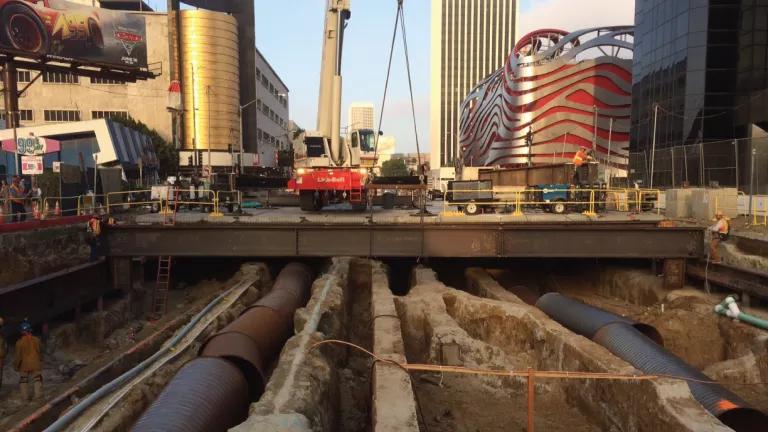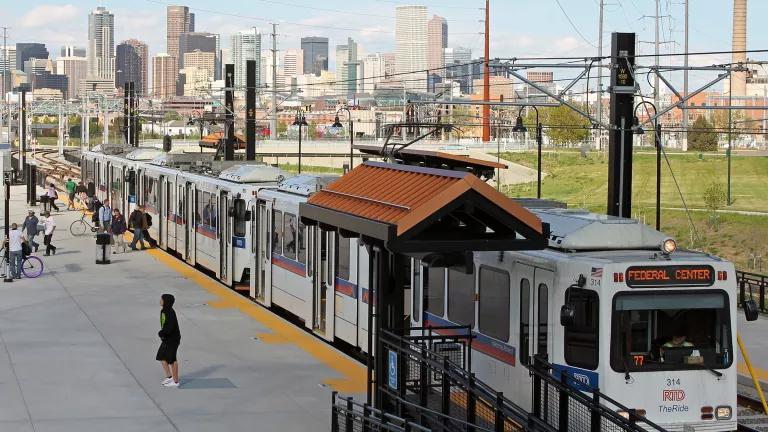LA Needs More Homes Near Our Next Subway to Cut Carbon

Los Angeles is leading the charge on the largest public transit build out in the country—one that will dramatically increase Angelenos’s access to fast, non-polluting mobility that will allow hundreds of thousands of trips a day without adding carbon emission and traffic. Realizing the full benefits of these billion-dollar investments requires also focusing on housing and development.
That’s why NRDC supports the effort by the Department of City Planning to develop Transit Neighborhood Plans for many of the new Metro Rail stations. We liked what they did with the Expo Line—although it could have been more ambitious and beneficial for the environment. And we’re very excited about the possibilities for more low-carbon housing near three new Purple Line stations at Wishire/La Cienega, Wilshire/Fairfax and Wilshire/La Brea. After all, public transit goes hand in hand with preserving and expanding access to housing, especially dedicated affordable housing, in the midst of our statewide housing crisis.
After early rounds of public engagement on the Purple Line TNP, City Planning is now formally scoping its environmental impact report that it will prepare according to the California Environmental Quality Act. The scoping process determines what key questions get asked and answered in the EIR, such as which environmental issues are explored, what scenarios are studied, and how to mitigate any impacts.
NRDC joined our partners Climate Resolve in submitting the following comments with the Department of City Planning.
Thank you for the opportunity to comment on the scope of the EIR for the Purple Line Transit Neighborhood Plan. On behalf of our organizations we write to support the Purple Line TNP’s objectives to:
- Ensure that the Project Area can grow in a sustainable, equitable, healthy, and inclusive manner;
- Expand and support a growing residential population;
- Promote a transit, bicycle, and pedestrian friendly environment, thereby reducing VMT and GHGs.
NRDC and Climate Resolve have consistently supported planning efforts, policy changes and legislation that facilitate higher density housing (especially affordable housing) near transit as an essential strategy for cities to meet climate change goals by reducing building and transportation emissions.
Conversely, the City of Los Angeles has repeatedly decreased allowable densities in the City over the last half-century through exclusionary zoning that has disproportionately harmed low-income communities of color. Further, this policy-created housing scarcity has driven up prices and led to a crisis of displacement and homelessness. The housing crisis has forced families into longer commutes that increase vehicle-miles-traveled, or out of the City entirely into communities with much weaker environmental goals and protections.
The Purple Line TNP offers an important starting point to undoing this harm. Dramatically increasing the allowable housing, especially affordable housing, while minimizing car trips, near the Purple Line Stations is a climate and environmental imperative. The neighborhoods in the study area are significantly less environmentally burdened than surrounding parts of Los Angeles, according to CalEnviroScreen 3.0. Failing to allow adequate new housing near the Purple Line will cause environmental harm by increasing vehicle-miles traveled and placing more members of Los Angeles’s growing population into environmentally burdened communities.
The City’s goals for housing and transit are reflected in the City’s Sustainability Plan. The Plan commits to “address LA’s housing shortage [by ensuring] that most new units are accessible to high-quality transit.” This includes goals of producing 57% of housing within 1,500 feet of transit by 2025 and 65% by 2035. Achieving these targets will help ensure that the City achieves the Plan’s goal of 50% of all journeys taking place by foot, bike and transit.
The Department of City Planning (DCP) should include the following considerations in the scope of its EIR.
Affordable Housing
- DCP should align any policy changes with the incentives offered in the Transit Oriented Communities program.
- DCP should discourage demolition of rent-stabilized apartments.
- DCP should assess the current progress towards achieving the Sustainability Plan’s goals for housing production near transit and set clear and transparent goals for new housing in the Purple Line TNP that achieve or exceed the Plan’s goals. DCP should commit to measuring and reporting progress towards achieving these goals at regular intervals and adjusting the TNP as necessary to reach them.
- All neighborhoods in the study area should be studied to accommodate significantly more housing. DCP should study a higher housing option, with more allowed density on the commercial corridors, as well as allowing up to four units in areas where apartments are currently banned. The EIR can then study the impact of this greater density on the Historic Preservation Overlay Zone areas since historic preservation is a CEQA area. DCP will find that allowing four-unit buildings will not impact historically contributing structures since they are protected by the HPOZ anyway. Non-contributing structures could be replaced with small multifamily buildings that fit with the neighborhood and house more Angelenos.
Transportation
- DCP should evaluate the impact of the plan on transit ridership.
- DCP should examine the regional vehicle-miles-traveled and greenhouse gas emissions impacts, to account for that fact that building in a dense, jobs-rich area near transit greatly reduces total GHG emissions.
- DCP should study how failing to allow new homes in a walkable, transit-rich, and high-opportunity community would accelerate displacement in lower-income neighborhoods, and thus increasing VMT by displacing transit riders to less expensive, and less transit-served communities.
- DCP should study removing parking requirements across the entire study area, even in places where there are no other zoning changes. California Environmental Quality Act has been updated, per SB 743 (2013), to hold that parking impacts are not an environmental impact as regards CEQA. Reducing parking requirements increases housing affordability and transit ridership, and reduces VMT.
Pollution Exposure
- DCP should evaluate the positive environmental benefits of allowing more people to live in a neighborhood with high levels of environmental quality as measured in the CalEnviroScreen 3.0. Conversely, DCP should measure the environmental harm that would be caused by failing to allow adequate housing in the study area and thus forcing more people to live in neighborhoods with higher degrees of exposure to pollution and environmental burdens.
- DCP should study the impact of future extreme heat by mid-century and end of century. UCLA climate research projects the study area to see minimal increases in extreme heat days by 2050, however many Los Angeles communities are projected to see extreme heat days increase by 200-300%. The EIR should study the environmental benefits of directing future population growth to areas with less extreme heat, and less attendant criteria air pollution exposure and energy demand.
It’s essential that we allow tens of thousands of new housing units, especially affordable housing, in the study area, both to address today’s housing crisis and to ensure that the next generation of Angelenos have healthy and safe places to live. Thank you for considering our comments. We look forward to continuing our engagement in this planning process.



